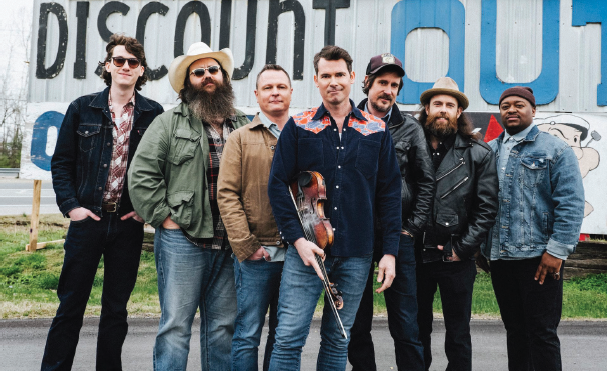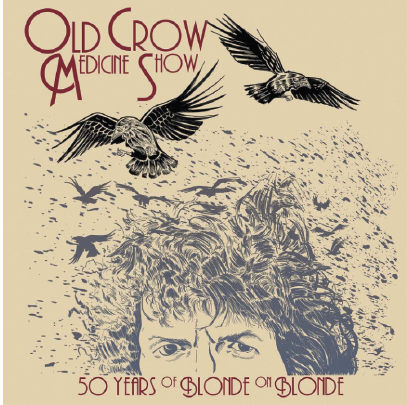|
By JIM HANCE Old Crow Medicine Show has been around for 25 years and has released about 20 albums and singles through those years. Its members are still pretty young compared to some of the other bands appearing at Suwannee Roots Revival. And they have something going for them even the other bands that have been performing together for twice that many years don’t have: broad commercial success. Being discovered by bluegrass legend Doc Watson in 2000 helped to propel them into recording their first album, Eutaw, in 2002, and then their highly successful album, O.C.M.S. in 2004. Ketch Secor wrote a song he called “Wagon Wheel” based on the sketch of a tune he discovered by Bob Dylan, and with Dylan’s consent the tune was published on O.C.M.S. with author credits of Secor/Dylan. The tune became a signature tune for Old Crow, and was later recorded by country artists Clay Underwood in 2009, Scott Shelby in 2012, and Darius Rucker in 2013. The band made frequent appearances on NPR’s A Prairie Home Companion, further building a reputation as a new top-tier band in the roots music category. Old Crow Medicine Show, with a following in roots, country, folk and rock genres, is the perfect headliner for the Suwannee Roots Revival festival. Open mics at the Little Grill Diner Ketch Secor and Chris “Critter” Fuqua met in the seventh grade in Harrisonburg, Virginia and began playing old time folk music together. They performed open mics at the Little Grill Diner. Secor had been going to Mt. Jackson, VA to the bluegrass Saturday night in the summer, and the Davis and Elkins College in West Virginia to participate in the Old-Time Music week there. Secor formed the Route 11 Boys with other budding musicians he met performing at Little Grill. Hitting the road busking Moving to upstate New York to attend college, Secor broke up his band in Virginia and mixed with other musicians in the area’s lively old time music scene. With Fuqua, Secor added Willie Watson, Ben Gould and Kevin Hayes to his regular playing buddies to form a group they called Trans:mission. With a cassette of ten songs they could sell on the road, they embarked on a tour busking across Canada to the west coast, circling back to settle into a farmhouse near Boone, North Carolina, where they were embraced by the Appalachian community. Their repertoire of old-time songs grew as they played with local musicians. Discovered by Doc Watson A sculpture of Doc Watson was installed outside a pharmacy at the corner of King and Depot streets in Boone, North Carolina in 2011, informing visitors that this is sacred territory for bluegrass music. That’s where the Old Crow Medicine Show was performing in 2000 when a woman led her blind father to hear the music. When introduced to the man as Doc Watson, the band began to play a well-known old-time tune they thought he might like, “Oh My Little Darling.” When they finished, Doc Watson said, “Boys, that was some of the most authentic old-time music I’ve heard in a long while. You almost got me crying.” Watson invited the band to participate in his annual MerleFest Music Festival in Wilkesboro, North Carolina. “That gig changed our lives, and we look to it as a pivotal turning point as Old Crow Medicine Show,” said Secor. He and Fuqua wrote a song about being on the corner in Boone and being discovered by Doc Watson. The tune honors Doc Watson and the high country blues sound. Embraced by Nashville — and Marty Stuart The chance encounter with Doc Watson led the same year to playing an outdoor Opryland Plaza show in Nashville. They made a move to Nashville, where they were embraced and mentored by Marty Stuart, who first heard the group perform at the Nashville-area Uncle Dave Macon Days Festival. They were added to Stuart’s Electric Barnyard Old-Fashioned Country Variety Show bus tour with acts like Merle Haggard and Connie Smith. Soon they were opening for Nashville artists that included Loretta Lynn, Dolly Parton, Ricky Skaggs and Del McCoury. In 2001, Old Crow Medicine Show made its debut at the Ryman Auditorium to play a four-minute song that received a standing ovation and a call for an encore. The band was performing at the Ohio Theatre in Cleveland when Marty Stuart unexpected appeared on stage. In front of the assembled Cleveland crowd, Stuart invited Old Crow Medicine Show to formally join the family and be inducted as ‘Member #201’ into the Grand Ole Opry, which occurred on September 17, 2013. (Keith Urban, and Darius Rucker — Rucker had just made “Wagon Wheel” a top 40 pop hit — had been inducted the previous year.) Headquartered in Nashville since 2001, Old Crow purchased and outfitted a building as their recording studio for new music projects and a live streaming variety show they produced called Hartland Hootenanny. “I approached the other Old Crows and said, ‘I really want to start a show that’s a cross between the Grand Ole Opry and Pee Wee’s Playhouse,’” said Secor. You can find the archived programs on the Old Crow Medicine Show YouTube home page, or check the page at crowmedicine.com/hartland-hootenanny where the episodes can be searched by featured guest. Appalachian tunes with punk energy Variously described as old-time, Americana, bluegrass, alternative country, and folk-country, the group started out infusing old Appalachian sounds with new punk energy. Country Music Television described their style of music as “tunes from jug bands and traveling shows, back porches and dance halls, southern Appalachian string music and Memphis blues.” “We just knew we wanted to combine the technical side of the old sound with the energy of a Nirvana,” Fuqua stated. Starting from old-time music in the Appalachian hills, the group found themselves making a foray into electric instruments and infusing a bit of rock’n’roll with their 2008 release Tennessee Pusher. Country music producer and musician Dave Rawlings offered, “I’ve always thought that a really important thing that the Old Crow Medicine Show brought to the table was new songs. Some reinterpreted old ones, some really nicely written and brand new — with the old flavor, but also with that vitality.” Asked about their early influences for music, Ketch Secor said John Hartford performed for his first grade class in Missouri, compelling him to play the banjo after that. Secor listed his major influences: “Certainly, Bob Dylan... Bob Dylan... Bob Dylan. More than anything else. More than any book or song or story or play. The work and the recorded work of Bob Dylan. It’s the most profound influence on me. And then the other people that really influenced me tend to be the same people who influenced Bob Dylan.” Critter Fuqua said he was infatuated with Guns N’ Roses and their 1987 release Appetite for Destruction in seventh grade. From then he knew he wanted to be a musician. Fuqua wrote “Take ‘Em Away” when he was 17, loosely based on Mance Lipscomb, a blues singer and sharecropper from Navasota County who he says “was a big influence on me.” Fuqua added that Bob Dylan was a huge influence on him as a songwriter. A Bob Dylan homage in 2017 In 2016, Old Crow Medicine Show, all fiddles and banjos, decided to perform Dylan’s iconic Blonde on Blonde album in its entirety to mark its 50th anniversary. A live Old Crow Medicine Show album was released in 2017. Rick Bayles for Americana-UK.com wrote a review of the album. “It’s worth taking a moment to remember just what an important record Dylan’s Blonde on Blonde is. It’s credited with being the first ever double album in rock music. It’s also reckoned to be at the very root of country rock — the first time rock musicians had gone to Nashville with the intention of working with session country players to produce a distinctive sound. It was a major influence on the Byrds, Gram Parsons, the Eagles, and many more. It is one of the great albums of the modern age and is still recognized as one of Dylan’s own personal best. You don’t mess with a legacy like that!” But Ketch Secor and the band did just that, and highlighted a connection between Bob Dylan and Americana music that had been largely unobserved. Bayles described a key difference between Dylan’s Blonde on Blonde and the OCMS interpretation: “The original is a studio-crafted album involving some of the finest musicians of the time, while the new cover is an all-live affair played by a single, integrated unit who have been on the road together for many years. In both cases the musicianship is outstanding, but the feel is very different. By all accounts Dylan knew he was creating something special.” Bayles wrote that the songs by OCMS are performed a bit faster than the originals in order to grab the attention of their live audience. “They play these songs in exactly the same order as they appeared on the original album so they don’t have time to build a mood — they have to grab the audience by the neck and drag them along with them, and they do it with exuberance and verve. From the opening ‘Rainy Day Women #12 & 35’ they’re off and running and you’d better keep up!” He also says OCMS found the country heart in Dylan’s songs and you start to see just how much country music is in some of Dylan’s earlier work. “This really is a great interpretation of a great album and you would do well to check it out. And then go back and re-visit the original as well. They really don’t make them like that anymore.” The 2024 schedule for Suwannee Roots Revival is not posted yet, but most likely Old Crow Medicine Show will have the main Amphitheater Stage on Saturday night. You might want to be there. Discography Eutaw (2001) Live (2003) O.C.M.S. (2004) Big Iron World (2006) Tennessee Pusher (2008) Carry Me Back (2012) Remedy (2014) 50 Years of Blonde on Blonde (2017) Volunteer (2018) Live at the Ryman (2019) Paint This Town (2022) Jubilee (2023)
1 Comment
12/24/2024 12:48:27 am
Detox Nashville: Seeking a drug or alcohol detox in Nashville? Find reputable centers offering safe and medically supervised detoxification programs. Begin your path to sobriety today.
Reply
Leave a Reply. |
Jim HanceStories about Cajun and Zydeco artists and their music. Archives
March 2025
|

 RSS Feed
RSS Feed

